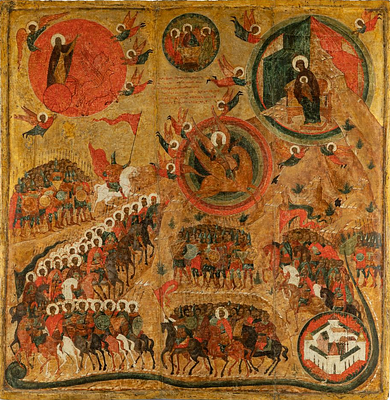Russian school, of the Old Believers, 18th century. "Saint Nicholas the Miraculous and his life in 16 hagiographic cells". Tempera, gold leaf on carve
Lot 52
About Seller
Setdart Auction House
Carrer Aragó 346
Barcelona
Spain
Setdart Subastas was born in 2004 and is currently the first online art auction in Spain with solidity, prestige and reliability guaranteed by our more than 60,000 users. Setdart has a young, dynamic and enterprising team ready to successfully manage the purchase and sale of art works through custom...Read more
Estimate:
EUR€7,000 - EUR€8,000
$7,291.67 - $8,333.33
Absentee vs Live bid
Two ways to bid:
- Leave a max absentee bid and the platform will bid on your behalf up to your maximum bid during the live auction.
- Bid live during the auction and your bids will be submitted real-time to the auctioneer.
Bid Increments
| Price | Bid Increment |
|---|---|
| EUR€0 | EUR€10 |
| EUR€200 | EUR€25 |
| EUR€500 | EUR€50 |
| EUR€1,000 | EUR€100 |
| EUR€3,000 | EUR€200 |
| EUR€5,000 | EUR€500 |
| EUR€10,000 | EUR€1,000 |
| EUR€20,000 | EUR€2,000 |
| EUR€50,000 | EUR€5,000 |
About Auction
By Setdart Auction House
Sep 23, 2021
Set Reminder
2021-09-23 10:00:00
2021-09-23 10:00:00
America/New_York
Bidsquare
Bidsquare : RUSSIAN ICONS
https://www.bidsquare.com/auctions/setdart-auction-house/russian-icons-7431
Setdart Auction House sofia@setdart.com
Setdart Auction House sofia@setdart.com
- Lot Description
Russian school, of the Old Believers, 18th century. "Saint Nicholas the Miraculous and his life in 16 hagiographic cells". Tempera, gold leaf on carved wooden panel. It presents a crack in the board, and jumps in the painting and the gilding. Measurements: 53 x 44 cm. Saint Nicholas Miraculous, as he is called in Russia, is the most beloved saint at the national level. Most of the churches have one or several icons of the saint, and he is the one who is asked for help in difficult life situations. The traditional depiction of St. Nicholas is a half-length frontal with a closed Gospel. The less frequent images are half-length with the Gospel open, like the one we see in the icon we are interested in. The page showing Saint Nicholas is the beginning of his veneration. This type of iconography has been known since the 13th century, but it became most popular in the later periods between the 18th and 19th centuries, which allows us to give a chronological approximation of the piece. The central representation of the saint is enclosed between 16 hagiographic cells, which recount his life and miracles. The icon should be read from the upper left-hand corner towards the right-hand corner, and then in the following order: the sixth image on the far left, the seventh on the far right, and so on, culminating with the sixteenth cell in the lower right-hand corner. Each of the scenes is identified by the inscriptions on the frame. They are somewhat deteriorated, but the scenes can be read well, such as the birth of Saint Nicholas, his baptism, several scenes of religious apprenticeship, his appointment as deacon in the fifth cell, followed by his appointment as priest, and then followed by seven scenes of miracles, culminating the composition with three scenes dedicated to the death and post-mortem cult of Saint Nicholas. In each of the corners of the icon are the four Evangelists. The pictorial quality of the miniatures is remarkable; they are a virtuoso architectural detail. What is striking about this lot, apart from the open Gospel, is that the frame of the icon is carved. This is a characteristic feature of Old Believers icons, as are the side inscriptions in black ink, and the two-fingered blessing gesture of Saint Nicholas. The Old Believers were a group of the Orthodox who, after Nikon's church reforms of 1654, decided to follow their opponent Avvakum, defending the traditional foundations of the Orthodox Church. Fleeing persecution, they settled in the Pomorie villages near the Urals and in Siberia. The Old Believers' Faith was legalised as early as 1905, sparking interest within the Russian Empire in the discovery of the national religious heritage, as well as developing a hitherto untried collecting of ancient icons.
- Shipping Info
-
In-house shipping available. Please inquire at admin@setdart.com.
-
- Buyer's Premium



 EUR
EUR CAD
CAD AUD
AUD GBP
GBP MXN
MXN HKD
HKD CNY
CNY MYR
MYR SEK
SEK SGD
SGD CHF
CHF THB
THB
















